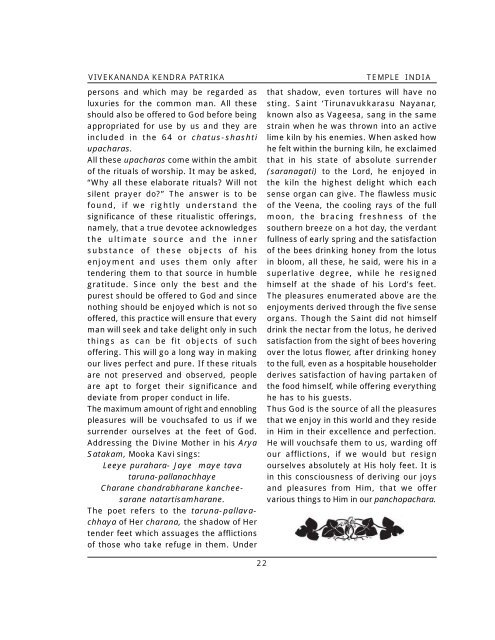Temples In India-1.pdf - Vivekananda Kendra Prakashan
Temples In India-1.pdf - Vivekananda Kendra Prakashan
Temples In India-1.pdf - Vivekananda Kendra Prakashan
Create successful ePaper yourself
Turn your PDF publications into a flip-book with our unique Google optimized e-Paper software.
VIVEKANANDA KENDRA PATRIKApersons and which may be regarded asluxuries for the common man. All theseshould also be offered to God before beingappropriated for use by us and they areincluded in the 64 or chatus-shashtiupacharas.All these upacharas come within the ambitof the rituals of worship. It may be asked,“Why all these elaborate rituals? Will notsilent prayer do?” The answer is to befound, if we rightly understand thesignificance of these ritualistic offerings,namely, that a true devotee acknowledgesthe ultimate source and the innersubstance of these objects of hisenjoyment and uses them only aftertendering them to that source in humblegratitude. Since only the best and thepurest should be offered to God and sincenothing should be enjoyed which is not sooffered, this practice will ensure that everyman will seek and take delight only in suchthings as can be fit objects of suchoffering. This will go a long way in makingour lives perfect and pure. If these ritualsare not preserved and observed, peopleare apt to forget their significance anddeviate from proper conduct in life.The maximum amount of right and ennoblingpleasures will be vouchsafed to us if wesurrender ourselves at the feet of God.Addressing the Divine Mother in his AryaSatakam, Mooka Kavi sings:Leeye purahara- Jaye maye tavataruna-pallanachhayeCharane chandrabharane kancheesaranenatartisamharane.The poet refers to the taruna-pallavachhayaof Her charana, the shadow of Hertender feet which assuages the afflictionsof those who take refuge in them. UnderTEMPLE INDIAthat shadow, even tortures will have nosting. Saint ‘Tirunavukkarasu Nayanar,known also as Vageesa, sang in the samestrain when he was thrown into an activelime kiln by his enemies. When asked howhe felt within the burning kiln, he exclaimedthat in his state of absolute surrender(saranagati) to the Lord, he enjoyed inthe kiln the highest delight which eachsense organ can give. The flawless musicof the Veena, the cooling rays of the fullmoon, the bracing freshness of thesouthern breeze on a hot day, the verdantfullness of early spring and the satisfactionof the bees drinking honey from the lotusin bloom, all these, he said, were his in asuperlative degree, while he resignedhimself at the shade of his Lord’s feet.The pleasures enumerated above are theenjoyments derived through the five senseorgans. Though the Saint did not himselfdrink the nectar from the lotus, he derivedsatisfaction from the sight of bees hoveringover the lotus flower, after drinking honeyto the full, even as a hospitable householderderives satisfaction of having partaken ofthe food himself, while offering everythinghe has to his guests.Thus God is the source of all the pleasuresthat we enjoy in this world and they residein Him in their excellence and perfection.He will vouchsafe them to us, warding offour afflictions, if we would but resignourselves absolutely at His holy feet. It isin this consciousness of deriving our joysand pleasures from Him, that we offervarious things to Him in our panchopachara.22
















